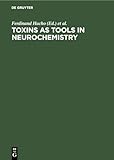Toxins as Tools in Neurochemistry : Proceedings of the Symposium Berlin (West), March 22–24, 1983 / ed. by Ferdinand Hucho, Yuri A. Ovchinnikov.
Material type: TextPublisher: Berlin ; Boston : De Gruyter, [2019]Copyright date: ©1983Edition: Reprint 2019Description: 1 online resource (368 p.) : Num. figsContent type:
TextPublisher: Berlin ; Boston : De Gruyter, [2019]Copyright date: ©1983Edition: Reprint 2019Description: 1 online resource (368 p.) : Num. figsContent type: - 9783110095937
- 9783110853162
- 591.188 19
- QP356.3 .T695 1983
- online - DeGruyter
| Item type | Current library | Call number | URL | Status | Notes | Barcode | |
|---|---|---|---|---|---|---|---|
 eBook
eBook
|
Biblioteca "Angelicum" Pont. Univ. S.Tommaso d'Aquino Nuvola online | online - DeGruyter (Browse shelf(Opens below)) | Online access | Not for loan (Accesso limitato) | Accesso per gli utenti autorizzati / Access for authorized users | (dgr)9783110853162 |
Frontmatter -- Preface -- Contents -- List of participants -- I. Na-Channels -- Kinetics of Neurotoxin Action at the Nodal Membrane -- Modification Of Sodium Channels With Scorpion Toxins And Alkaloids -- Synthesis of Steroid Alkaloids Active on Sodium Channels -- Batrachotoxin - a Tool for Elucidating the Sodium Channel Functional Organization -- Identification of Sodium Channel Components Interacting with Neurotoxins -- Voltage-Dependent Na-Channels: Comparative Studies in Electrophorus Electricus Preparations -- The Interaction of Neurotoxins with the Soluble Proteins of the Excitable Tissues -- II. Palytoxin -- Caribbean Palytoxin - A New Tool in Membrane Research -- Physiological and Morphological Effects of Palytoxin (Palythoa Caribaeorum) on Skeletal Muscle -- Palytoxin - A Cation Ionophore? -- III. Acetylcholine Receptors -- Venoms and Toxins in Neurochemical Research of Insects -- Are there Nicotinic Acetylcholine Receptors in Invertebrate Ganglionic Tissue? -- The Sites of Neurotoxicity in a-Cobratoxin -- α-Cobratoxin and α-Bungarotoxin, Two Members of the "Long" Neurotoxin Family - A Structural Comparison -- Acetylcholine Receptor Interaction with the Neurotoxin II Photoactivable Derivatives -- Fluorescence and Circular Dichroism Studies on Snake Venom Neurotoxins and Their Derivatives -- Magnetic Resonance Evaluation of Snake Neurotoxin Structure-Function Relationship -- Photolabeling of Acetylcholine Receptor States with Triphenylmethylphosphonium -- α-Bungarotoxin and Strychnine as Tools to Characterize Neurotransmitter Receptors of the Central Nervous System -- IV. Ca-Channels, Axonal Toxins, Presynaptic Toxins, Cardiotoxin, New Venoms -- Interaction of Toxins and Divalent Cations in Calcium Channels of the Neuronal Membrane -- Toxins Isolated from the Venom of the Scorpion Centruroides Sculpturatus: Chemical Structure and Electrophysiological Effects -- Chemical Modification of the Sea Anemone Toxin II from Anemonia Sulcata: Synthesis of a Toxic, Phosphorescent Derivative -- NMR Conformational Study: Polypeptide Neurotoxins - Honey-Bee Apamin and Scorpion Insectotoxin I5A -- Effects of Different Spider Venoms on Artificial and Biological Membranes -- Structural Peculiarities and Mechanism of Action of Presynaptically Acting Neurotoxins from Venoms of Latrodectus and Lithyphantes Spiders -- Myotoxic and Neurotoxic Phospholipases A -- β-Bungarotoxin; New Aspects of an Old Approach to the Presynaptic Membrane -- Neurotoxins as Tools in Cardiac Excitation Coupling -- Index -- Backmatter
restricted access online access with authorization star
http://purl.org/coar/access_right/c_16ec
Mode of access: Internet via World Wide Web.
In English.
Description based on online resource; title from PDF title page (publisher's Web site, viewed 30. Aug 2021)


